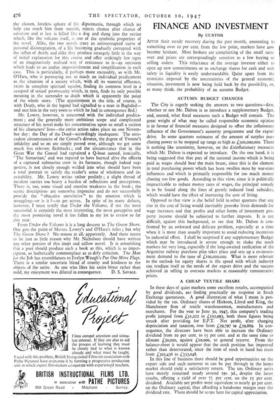FINANCE AND INVESTMENT
By CUSTOS
AFFER their steady recovery during the past month, amounting to something over so per cent, from the low point, markets have now become hesitant. Most brokers are complaining of the small ,turn- over and prices are correspondingly sensitive to a few buying or selling orders. This reluctance of the average investor either to open up new commitments or to exchange shares for cash and seek safety in liquidity is easily understandable. -Quite apart from the restraints imposed by the uncertainties of the general economic situation, investment is now being held back by the possibility, or, as many think, the probability of an autumn Budget.
AUTUMN BUDGET CHANCES The City is eagerly seeking the answers to two questions—first, whether or not Mr. Dalton is to introduce a supplementary Budget, and, second, what fiscal measures such a Budget will contain. The great weight of what may be called responsible economic opinion is in favour of financial measures designed to offset the inflationary influence of the Government's austerity programme and the export drive. In some quarters estimates of the amount of surplus pur- chasing power to be mopped up range as high as £500,000,000. There is nothing like unanimity, however, on the disinflationary measures which Mr. Dalton is. expected to introduce. On the one hand, it is being suggested that that part of the national income which is being paid as wages should bear the main brunt, since this is the element in total purchasing power which has been swollen most by war-time influences and which is primarily responsible for too much money chasing too few goods. According to this view, since it is politically impracticable to reduce money rates of wages, the principal remedy is to be found along the lines of greatly reduced food subsidies, which would have the effect of increasing the cost of living.
Opposed to that view is the belief held in other quarters that any rise in the cost of living would inevitably provoke fresh demands for wage increases and that profits and other forms of investment pro- perty income should be subjected to further imposts. It is not difficult, against this background, to see that Mr. Dalton is con- fronted by an awkward and delicate problem, especially at a time when it is more than usually important to avoid reducing incentives to industrial effort. I shall be surprised if any supplementary Budget which may be introduced is severe enough to shake the stock markets for very long, especially if the long-awaited ratification of the Argentine railway purchase plan takes place and sets up a re-invest- ment demand to the tune of Lsoo,000,000. What is more relevant to the outlook for equity shares is the speed with which industry can readjust itself to the needs of the export drive and the success achieved in selling in overseas markets at reasonably remunerative prices.
A CHEAP TEXTILE SHARE
In these days of quiet markets some excellent results, accompanied by good dividends, are finding practically no response in Stock Exchange quotations. A good illustration of what I mean is pro- vided by the los. Ordinary shares of Hickson, Lloyd and King, the Manchester firm of textile warehousemen, manufacturers and merchants. For the year to June 30, 1947, this company's trading profit jumped from L- 51,222 tO D03,993, both these figures being struck after providing for E.P.T. Net profit, after charging depreciation and taxation, rose from £29,797 to £59,869. In con- sequence, the directors have been able to increase the Ordinary dividend from ro per cent. to 15 per cent, and at the same time to allocate £30,000, against Lio,000, to general reserve. From the balance-sheet it would appear that the stock position has improved rather than 'deteriorated, since the item of stock in hand has risen from £303,436 to £333,048.
In this line of business there should be good opportunities on the export side and such turnover as can be put through in the home market should yield a satisfactory return. The los. Ordinary units have merely remained steady around 19s. 3d., despite the latest results, offering a yield of over 7f per cent, on the 15 per cent. dividend. Available net profits were equivalent to nearly 40 per cent. on the Ordinary capital, thus affording a handsome margin over the dividend rate. There should be scope here for capital appreciation.


































 Previous page
Previous page